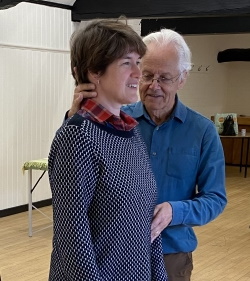



The TYA hosted a beautiful and informative workshop with Ron Colyer during November last year for our Yoga teachers. Ron is a violinist who has played with both the Philharmonia Orchestra of London and the BBC Symphony Orchestra. He is also a veteran Alexander Technique teacher, and it was for this latter skill that we invited him to run a workshop for us.
One of the most difficult things to negotiate as a Yoga teacher is finding the words that will keep the students’ awareness focussed on what they are doing and how they are doing it, rather than reaching for a final or ‘perfect’ posture. This is what makes Yoga different from other ‘exercise’ routines: the primary focus in Yoga is on the process rather than any result. Paschimottanasana, for example, may stretch the hamstrings and back extensors, but that’s not our focus in doing it; the Yogin focusses on the proprioceptive and interoceptive feedback in the doing of it ~ thus training the awareness (buddhi1) ~ rather than focussing on how far we get our heads down towards our knees.Mathias Alexander, the founder of the Alexander Technique, spoke of this as staying with ‘the means whereby’ rather than ‘end-gaining’.
Ron began the workshop by reminding us of Patanjali’s description of Yoga in the very first chapter of his Yoga Sutra-s:
yogaś
citta-vṛtti-nirodhaḥ || 1:2 ||
Yoga is the inhibition of the movement of thought in the mind. (1:2)
The Sanskrit word ‘nirodha’ ~ translated here as ‘inhibition’ ~ comes from ni = down, into + rodha = to arrest, to avert. Yoga is ~ whether we are doing asana (the physical movement of Yoga) or pranayama (Yoga breathwork) or sitting in silent dhyanam (meditation) ~ the arresting or inhibition of that constant flow of thought. For what reason?
tadā
draṣṭuḥ sva rūpe-avasthānam || 1:3 ||
Then the seer becomes established in his/her true identity. (1:3)
vṛtti-sārūpyam-itaratra || 1:4 ||
At other times (the seer) identifies with whatever thought is chosen from the flow of the many. (1:4)
If we are seeking to know our reality, to glimpse our whole, unfragmented self, we have to cease to focus on what we think we are ~ only then are we able to see through the busy mind to the reality of what we actually are. And key to this is awareness (buddhi1), our instrument for transcending our current state of mind or consciousness. Mind is the gap!
It's a mighty task.
Ron reminded us that Alexander had come to the realisation that, in order to move in a way that is in accord with the intrinsic intelligence of the body, we have to ‘get ourselves out of the way’; we have to move without imposing movement on ourselves. He talked us through the many ways of articulating instructions that would help us and our students achieve this.
Body and mind are still active in this doing, but the awareness allows the ‘I’ (ahamkara) to briefly step aside and let the wisdom of the body move us. Thus our asana becomes a way of training buddhi, nudging it in the direction of being open to transforming into buddha1 ~ the awakened.
Shaktipat ~ Where Tina Comes In
Anyone who has ever been for an Alexander session, will have experienced sitting in a chair with their teacher, standing next to or behind them, often with their hands resting lightly on one’s shoulders or the back of one’s neck. As the workshop with Ron went on and we witnessed him taking this stance with students, he took us to another of Alexander’s wisdoms: the teacher would be focussing not only on the student but on him/herself ~ and thereby ensuring that his or her own body was not holding tension, because such tension would communicate itself to the student.
In this way asana itself becomes a contemplative practice ~ training the awareness for dharana (focus), the prerequisite of dhyanam (meditation).
Along with many others, I was saddened by the death of Tina Turner. I had never seen her live but had listened and watched her extraordinary voice and performance on telly a number of times. One was always moved by that burst of vitality and power as she sang and danced across the stage. I knew the story of her life and ~ again, like many others ~ admired the way she had overcome extraordinary odds to walk her own path.
As BBC Radio 4 recounted incidents from her life, one snippet of information struck me: we all know that Tina was a dedicated Buddhist and chanted daily. What I learned that day from the radio was that Tina chanted for a couple of hours before every concert, in her chanting asking that each person that experienced her performance, got what they needed from it.
Awesome!
Our biofield (our electromagnetic field; which the ancient Yogin and Chinese physicians called the Prana or Qi field, and which they said was infused with our ‘svabhav’ ~ our own state of being) extends way beyond the boundary of our skin. That ‘silent’ communication extends to ‘others’ and often fills a room. A person in a deep depression, for example, might smile to the room, but their sadness is still felt ~ although acknowledged, perhaps, by just a few. We are all in touch with each other’s biofield, although our sensitivities to it have to be trained. What Tina was doing could better be termed ‘shaktipat’ ~ which in traditional yoga refers to a deliberate and conscious transmission of shakti from guru to disciple. In Tina’s case it was from her to those who had come out to witness her performance.
There are numerous recorded instances of shaktipat ~ what Abhinavagupta (a 10th century mystic and philosopher from Kashmiri Shaivite tradition) referred to as ‘the light rays of awakened consciousness’. To have such an experience ~ in which our individuality dissolves and we merge with the universal consciousness ~ is also known as ‘anubhav’. It is a gift of the guru.
However, we all are transmitting our prana all the time ~ whatever our individual ‘bhav2’ may be. The guru might transmit the experience of ‘anubhav’
What are we silently communicating? What are our wishes for our students, as we step in to teach a class?
Sure, many of us prepare a class, looking to its structure and flow: what we will do with our students, how we will develop and build on what we taught in our last encounter with them. But what work do we do on ourselves?
Tina chanted for two hours, wishing the best for each individual in the audience at that particular show, and stepped onto the stage with that wish alive in her. How long do we ~ as teachers of Yoga ~ spend on preparing our own ‘bhav’ so that the shakti we share with our students is one that wishes them all good things? Is that wish simply a passing thought, or is it something we should be engaging in in a more deliberate and intention-filled way?
Do we ever consider the shakti we carry into the Yoga studio? If we do, is it possible that for the period of time of the class, at least, we are being Yoga, rather than simply teaching it?
There is a beautiful and ancient ‘shantipath’ (Path of Peace) mantra we could chant if, like Tina, we want to give ourselves time and consciousness to prepare svabhava for a class:
ॐ सह नाववतु सह नौ
भुनक्तु
सह वीर्यम् करवावहै
तेजस्विनावधीतम्
अस्तु मा
विद्विषावहै
ॐ शान्तिः शान्तिः
शान्तिः
om saha nāvavatu saha nau bhunaktu
saha vīryam karavāvahai
tejasvināvadhītam astu mā vidviṣāvahai
om śāntiḥ śāntiḥ śāntiḥ
May we both, the teacher and the taught, be protected.
May we attain strength together.
May our study fill us with light and energy.
May there be no disharmony between us.
OM. Peace, peace, peace
In this way, and in these troubled times, let all that we give in a class ~ the visible and the invisible ~ offer peace, peace, peace.
References :
[1] Buddhi:
in Yoga philosophy, the first component to emerge from prakriti (nature); ; it comes from the Sanskrit root budh =
awaken. When the individual buddhi is awakened to its truth, it is said to be awakened ~ buddha.
[2] Bhav, comes from the Sanskrit root verb bhū = to be. Bhava is the inner landscape, the
spirit or experience that inhabits us at any one time. Anubhav is the experience of Oneness.
©Swami Ambikananda, Jan 2024
Copyright © The Trustees of the Traditional Yoga Association®, 2023. All rights reserved.
Privacy Policy